Thermal Catalytic Depolymerization of Poly(L-Lactic Acid) Oligomer ...
Thermal Catalytic Depolymerization of Poly(L-Lactic Acid) Oligomer ...
Thermal Catalytic Depolymerization of Poly(L-Lactic Acid) Oligomer ...
You also want an ePaper? Increase the reach of your titles
YUMPU automatically turns print PDFs into web optimized ePapers that Google loves.
April 1999 Chem. Pharm. Bull. 47(4) 467—471 (1999) 467<br />
<strong>Thermal</strong> <strong>Catalytic</strong> <strong>Depolymerization</strong> <strong>of</strong> <strong>Poly</strong>(L-<strong>Lactic</strong> <strong>Acid</strong>) <strong>Oligomer</strong> into<br />
LL-Lactide: Effects <strong>of</strong> Al, Ti, Zn and Zr Compounds as Catalysts<br />
Masaki NODA* and Hisashi OKUYAMA<br />
Technology Research Laboratory, Shimadzu Corp., 1 Kuwabaracho, Nishinokyo, Nakagyo-ku, Kyoto 604, Japan.<br />
Received September 14, 1998; accepted January 8, 1999<br />
A series <strong>of</strong> Al, Ti, Zn and Zr compounds, i.e., their metal alkoxides, organic acid and enolate salts, halid and<br />
oxide, were evaluated as intramolecular transesterification catalysts for the thermal depolymerization reaction <strong>of</strong><br />
poly(L-lactic acid) oligomer resulting in LL-lactide, meso-lactide and DD-lactide by gas chromatography using a bbcyclodexstrin<br />
chiral stationary phase capillary column. The activity <strong>of</strong> the intramolecular transesterification<br />
compared with that <strong>of</strong> stannous 2-ethylhexanoate was in the following order: SnZnZrTiAl.<br />
Key words optically active lactide; thermal depolymerization catalyst; poly(L-lactic acid) oligomer<br />
The use <strong>of</strong> L-lactic acid (L-LA) (1) to produce poly(L-lactic<br />
acid) (L-PLA) is well known in the medical industry as a biocompatible<br />
and biodegradable polymer for applications such<br />
as sutures, clamps, boneplates and biologically controlled devices.<br />
Recently, problems associated with the incineration <strong>of</strong><br />
waste have led to the need for the development <strong>of</strong> truly<br />
biodegradable polymers to be utilized as substitutes for nonbiodegradable<br />
petrochemical-based polymers in packaging,<br />
consumer goods, etc. 1) The large-scale commercial production<br />
<strong>of</strong> L-PLA for use in non-medical product application<br />
should be maximized for yield and minimized for other overall<br />
cost factors to compete with low-cost polymers made<br />
from petrochemicals.<br />
L-PLA has been conventionally produced by a ring-opening<br />
polymerization <strong>of</strong> LL-lactide (a cyclized dimer <strong>of</strong> L-LA)<br />
(4a), which is produced by the thermal depolymerization <strong>of</strong> a<br />
low molecular weight L-PLA oligomer (2). 2) Recently, the direct<br />
polymerization <strong>of</strong> L-LA has been realized with various<br />
Brfnsted and Lewis acid catalysts through continuous<br />
azeotropic distillation. 3) Since L-LA has been produced by a<br />
multi-step purification process in the fermentation method,<br />
facile efficient purification <strong>of</strong> L-LA is crucial for producing<br />
L-PLA. Thus, the conventional L-PLA production via lactide,<br />
which can be produced from crude L-LA and is isolated as a<br />
purified intermediate, should be one <strong>of</strong> the efficient methods<br />
for producing L-PLA.<br />
LL-Lactide production by thermal depolymerization <strong>of</strong> the<br />
L-PLA oligomer was reported in the presence <strong>of</strong> catalysts<br />
such as stannous 2-ethylhexanoate (Sn(oct) 2 ) 4,5) and Sb 2 O 3 . 6,7)<br />
These catalysts have been used in terms <strong>of</strong> activity and selectivity<br />
at the thermal depolymerization <strong>of</strong> the L-PLA oligomer.<br />
However, the reaction residue contains the metal compound<br />
used as the catalyst, as well as the unreacted oligomer, together<br />
with their decomposed materials. Treatment <strong>of</strong> the<br />
waste products <strong>of</strong> the residue is a problem in the commercial<br />
production <strong>of</strong> LL-lactide, depending on the toxicity <strong>of</strong> the catalysts.<br />
Studies on the catalysts <strong>of</strong> thermal depolymerization<br />
have not been extensively reported compared with the polymerization<br />
catalysts 8) <strong>of</strong> lactide to L-PLA. Practical catalysts<br />
for large scale lactide production must be investigated. This<br />
paper describes the evaluation <strong>of</strong> homogeneous catalysts<br />
such as metal alkoxides, organic acid and enolate salts <strong>of</strong><br />
metals, and metal halide and oxide, which are less toxic<br />
metal compounds than tin compounds, compared with con-<br />
ventionally used stannous 2-ethylhexanoate. 9)<br />
Results<br />
The thermal depolymerization <strong>of</strong> L-PLA oligomer (2) with<br />
various catalysts was performed by distillation at 190—<br />
245 °C under 4—5 mmHg, in which intramolecular transesterification,<br />
i.e., a “back-biting reaction” <strong>of</strong> the L-PLA<br />
oligomer, occurs to give LL-lactide (4a).The metals employed<br />
as alkoxides, organic acid and enolate salts were Al, Ti, Zn<br />
and Zr. These are Lewis acids with mild electrophilicity and<br />
are homogeneous catalysts. The distillate <strong>of</strong> crude LL-lactide<br />
(4a), accompanied by small amounts <strong>of</strong> the resulting mesolactide<br />
(4b) and DD-lactide (4c) during depolymerization, was<br />
analyzed by gas chromatography (GC) using a b-cyclodextrin<br />
(CD) chiral stationary phase capillary column. The depolymerization<br />
conditions, yields <strong>of</strong> crude lactide and optically<br />
active lactide isomers (4a, 4b, 4c) are shown in Table 1.<br />
<strong>Thermal</strong> depolymerization with 1 mol% <strong>of</strong> aluminum<br />
alkoxids and enolate salt (Al(iso-PrO) 3 , Al(etac) 3 , (AlO(iso-<br />
PrO)) 3 ) gave about 40% yield <strong>of</strong> crude lactide at 190—<br />
230 °C for 2 h, and further depolymerization gave 72—75%<br />
yields at 230—245 °C for an aditional 1 h. <strong>Depolymerization</strong><br />
Chart 1<br />
∗ To whom correspondence should be addressed. © 1999 Pharmaceutical Society <strong>of</strong> Japan
468 Vol. 47, No. 4<br />
Table 1. LL-Lactide (4a), Meso-Lactide (4b) and DD-Lactide (4c) Formation in <strong>Thermal</strong> <strong>Depolymerization</strong> <strong>of</strong> L-PLA <strong>Oligomer</strong><br />
Entry Catalyst<br />
Cat./L-PLA oligomer a) Distillation c) Yields<br />
wt % (mol% b) ) time (min) (%)<br />
with 0.2 mol% <strong>of</strong> Al(etac) 3 provided a low yield <strong>of</strong> lactide<br />
(59%, at 190—245 °C for 2.7 h) (Fig. 1). The lactide distilled<br />
under the depolymerization with 1 mol% <strong>of</strong> these aluminum<br />
compounds contain rather higher yields <strong>of</strong> 4b and 4c (16.4—<br />
GC analysis <strong>of</strong> distillate lactide d)<br />
LL DD meso by-products<br />
1 Al(iso-PrO) 3 2.7 (1) 180 l)<br />
75.4 78.89 2.14 16.50 1.47 95.40<br />
2 Al(etac f ) ) 3 5.36 (1) 180 l)<br />
72.5 79.21 2.18 16.41 2.05 95.14<br />
3 Al(etac f ) ) 3 1.13 (0.2) 160 l)<br />
59.0 87.46 1.10 10.48 0.96 97.52<br />
4 (AlO(iso-PrO)) 3 4.01 (1) 180 l)<br />
71.6 78.59 2.98 17.65 0.78 94.52<br />
5 Ti(iso-PrO) 4 0.77 (0.2) 80 41.9 90.91 0.36 7.18 0.64 99.22<br />
6 Ti(iso-PrO) 4 3.74 (1) 100 42.7 87.41 0.67 9.16 2.72 98.48<br />
7 Ti(iso-PrO) 2 (acacj)) 2 0.99 (0.2) 80 42.8 91.20 0.33 6.67 1.87 99.28<br />
8 Ti(acac j) )4 1.20 (0.2) 80 43.4 89.62 0.48 8.70 1.20 98.94<br />
9 Ti(OH) 2 (LA) 2 0.71 (0.2) 80 46.5 92.83 0.34 5.61 1.23 99.28<br />
76.3 94.70 0.24 2.94 2.13 99.50<br />
10 Zn(hexa g) ) 2 0.81 (0.2) 140 l)<br />
11 Zn(hexa g) ) 2 3.92 (1) 80 86.0 93.58 0.20 3.55 2.68 99.58<br />
12 Zn(stea h) ) 2 1.70 (0.2) 160 l)<br />
92.0 93.70 0.16 4.04 2.10 99.66<br />
13 Zn(stea h) ) 2 7.95 (1) 120 84.9 94.88 0.10 3.60 1.43 99.78<br />
14 Zn(naph i) ) 2 2.19 (0.2) 100 l)<br />
90.0 93.83 0.20 4.00 1.97 99.16<br />
15 Zn(naph i) ) 2 10.06 (1) 80 87.3 97.38 0 2.14 0.48 100<br />
16 ZnCl2 1.83 (1) 80 89.3 95.72 0 2.44 1.13 100<br />
17 Zr(n-PrO) 4 0.89 (0.2) 120 l)<br />
77.4 94.41 0.18 4.51 0.90 99.62<br />
18 Zr(n-PrO) 4 4.92 (1) 100 78.0 89.36 0.74 8.76 1.14 98.36<br />
19 ZrO(stea h) ) 2 1.82 (0.2) 160 l)<br />
70.4 96.98 0.14 2.53 0.36 99.72<br />
20 ZrO(stea h) ) 2 8.42 (1) 120 82.8 92.14 0.60 6.55 0.71 98.70<br />
21 Zr(acac j) ) 4 1.32 (0.2) 120 l)<br />
66.4 93.11 0.21 5.42 1.26 99.54<br />
22 Zr(acac j) ) 4 6.24 (1) 100 84.9 90.83 0.78 8.39 0 98.30<br />
23 Zr(n-BuO) 3 (acac j) ) 11.05 (1) 80 74.0 88.78 0.88 9.21 1.13 98.04<br />
24 Zr(n-BuO)(acac j) )(etac f ) ) 2 9.97 (1) 100 83.2 90.25 0.76 7.63 1.36 98.32<br />
25 ZrO(AcO) 2 7.68 (1) 100 72.9 91.58 0.55 7.20 0.66 98.80<br />
26 ZrO(OH) 2 1.89 (1) 120 50.6 96.47 0 1.66 1.87 100<br />
27 ZrO2 1.65 (1) 180 63.8 96.75 0 2.01 1.24 100<br />
28 Sn(oct k) ) 2 1.09 (0.2) 60 89.3 97.88 0 1.67 0.46 100<br />
a) Mw1170, L-PLA oligomer consists <strong>of</strong> 16 units <strong>of</strong> LA. b) Mole numbers <strong>of</strong> PLA oligomer were calculated as LA unit constituents. c) At 190—230 °C under 4—<br />
5 mm Hg. d) b-CD-stationary phase chiral column (CHROMPACK, CP-cyclodextrin-b-236M-19) was used. e) ee (%) is calculated from 4a and 4c values. f ) etac: ethyl<br />
acetoacetate. g) hexa: hexanoate. h) stea: stearate. i) naph: naphthenate, j) acac: acetylacetonate. k) oct: octoate (2-ethylhexanoate). l) Distillation at 190—245°C.<br />
Fig. 1. Lactide Formation by the <strong>Thermal</strong> <strong>Depolymerization</strong> <strong>of</strong> L-PLA <strong>Oligomer</strong> in the Presence <strong>of</strong> Organoaluminum Compounds<br />
From the point indicated with an arrow, the reaction was heated at 230—245 °C.<br />
eee) (%)<br />
17.7% and 2.1—3.0%, respectively). However, 0.2 mol% <strong>of</strong><br />
Al(etac) 3 provided lower yields <strong>of</strong> 4b and 4c (10.5 and<br />
1.1%, respectively) than those <strong>of</strong> the lactide obtained by the<br />
depolymerization with 1 mol% <strong>of</strong> the catalysts (Table 1, en-
April 1999 469<br />
Fig. 2. Lactide Formation by the <strong>Thermal</strong> <strong>Depolymerization</strong> <strong>of</strong> L-PLA <strong>Oligomer</strong> in the Presence <strong>of</strong> Organotitanium Compounds<br />
Fig. 3. Lactide Formation by the <strong>Thermal</strong> <strong>Depolymerization</strong> <strong>of</strong> L-PLA <strong>Oligomer</strong> in the Presence <strong>of</strong> Organozinc Compounds and Stannous 2-Ethylhexanoate<br />
From the point indicated with an arrow, the reaction was heated at 230—245 °C.<br />
tries 1—4).<br />
The results <strong>of</strong> titanium alkoxides, enolate and acid salts<br />
(Ti(iso-PrO) 4 , Ti(iso-PrO) 2 (acac) 2 , Ti(acac) 4 , Ti(OH) 2 (LA) 2 )<br />
are shown in Fig. 2 and Table 1, entries 5—9. The depolymerization<br />
with 0.2 mol% <strong>of</strong> the catalysts provided 42—47%<br />
<strong>of</strong> crude lactide at 190—230 °C for 1.3 h. There were no differences<br />
in the yields <strong>of</strong> the lactide depending on the catalyst<br />
concentrations (0.2 and 1 mol%), or the alkyl groups <strong>of</strong><br />
alkoxide, carboxlyic acid and enolate <strong>of</strong> the titanium compounds.<br />
These catalysts have the activity <strong>of</strong> the back-biting<br />
reaction <strong>of</strong> the L-PLA oligomer with low concentrations <strong>of</strong><br />
the catalysts (0.2 mol%), as well as strong activity <strong>of</strong> polymerization<br />
<strong>of</strong> the oligomer resulting in a higher molecular<br />
weight <strong>of</strong> L-PLA. The yields <strong>of</strong> 4b and 4c were 5.6—9.2 and<br />
0.3—0.7%, respectively.<br />
Organic acid salts <strong>of</strong> zinc (hexanoate, stearate and naphthenate)<br />
and zinc chloride were evaluated (Fig. 3, Table 1,<br />
entries 10—16). <strong>Depolymerization</strong> with the acid salts <strong>of</strong> zinc<br />
(0.2 mol%) gave 67—72% yields <strong>of</strong> lactide at 190—230 °C<br />
for 2 h, and further reaction gave a 76—92% yield at 230—<br />
245 °C. The depolymerization with Zn(hexa) 2 and ZnCl 2 (1<br />
mol%) provided an 85—87% yield <strong>of</strong> lactide at 190—230 °C<br />
for 1.3 h, and the reaction with Zn(stea) 2 (1 mol%) gave 85%<br />
yield at 190—230 °C for 2 h, respectively. The results <strong>of</strong><br />
ZnCl 2 provided almost the same yield <strong>of</strong> lactide as that <strong>of</strong><br />
Zn(hexa) 2 . The crude lactide obtained from the depolymerization<br />
with zinc compounds (1 mol%) contained 4b (2.1—<br />
3.6%) and 4c (0—0.2%), respectively. However, the depoly-
470 Vol. 47, No. 4<br />
Fig. 4. Lactide Formation by the <strong>Thermal</strong> <strong>Depolymerization</strong> <strong>of</strong> L-PLA <strong>Oligomer</strong> in the Presence <strong>of</strong> Zirconium Compounds<br />
From the point indicated with an arrow, the reaction was heated at 230—245 °C.<br />
merization with low concentrations <strong>of</strong> the zinc compounds<br />
(0.2 mol%) afforded rather higher yields <strong>of</strong> 4b and 4c (2.9—<br />
4.0%, and 0.2%, respectively). Zirconium alkoxides, enolates<br />
(Zr(n-PrO) 4 , Zr(acac) 4 , Zr(n-BuO) 3 (acac), Zr(n-BuO)(acac)<br />
(etac) 2 ), zirconyl stearate (ZrO(stea) 2 ), zirconyl acetate<br />
(ZrO(AcO) 2 ), zirconyl hydroxide (ZrO(OH) 2 ) and zirconium<br />
oxide (ZrO 2 ) were evaluated (Fig. 4, Table 1, entries 17—<br />
27). <strong>Depolymerization</strong> with 0.2% mole <strong>of</strong> zirconium compounds<br />
(Zr(n-PrO) 4 , Zr(acac) 4 , ZrO(stea) 2 ) provided a 66—<br />
77% yield <strong>of</strong> lactide at 190—245 °C for 2 h. The reaction<br />
with 1 mol% <strong>of</strong> the zirconium catalysts, except zirconyl hydroxide<br />
and zirconium oxide, under the same depolymerization<br />
conditions gave a 78—85% yield <strong>of</strong> lactide. <strong>Depolymerization</strong><br />
with zirconyl hydroxide (1 mol%) and zirconium<br />
oxide (1 mol%) provided 51—55% yields <strong>of</strong> lactide for 2 h,<br />
which are lower yields than those from the other zirconium<br />
compounds. The yields <strong>of</strong> 4b and 4c in the case <strong>of</strong> the 1<br />
mol% <strong>of</strong> the catalysts were 6.6—9.2% and 0.6—0.9%, respectively,<br />
and in the case <strong>of</strong> 0.2 mol% <strong>of</strong> the catalysts, 2.5—<br />
5.4 % and 0.1—0.2%, respectively.<br />
<strong>Depolymerization</strong> with stannous 2-ethylhexanoate (0.2<br />
mol%) most efficiently provided 89% yield <strong>of</strong> lactide at<br />
190—230 °C for 1 h (Fig. 3). The yields <strong>of</strong> 4b and 4c were<br />
1.7% and 0%, respectively (Table 1, entry 28).<br />
Discussion<br />
The focus <strong>of</strong> this research has been to evaluate metal compounds<br />
for developing practical catalysts for the large-scale<br />
commercial production <strong>of</strong> lactide. It is well known that thermal<br />
depolymerization <strong>of</strong> the L-PLA oligomer gave 4a via intramolecular<br />
transesterification, i.e., a back-biting reaction. It<br />
is also well known that metal alkoxides such as aluminium<br />
isopropoxide, 10) titanium 11) or zirconium propoxides are good<br />
transesterification catalysts under conditions used for the<br />
technical production <strong>of</strong> polyesters. Metal alkoxide compounds<br />
with free d or p orbitals react as coordination (or<br />
complexation) initiators. Due to these factors, our investigation<br />
centered on Al, Ti, Zn and Zr compounds as intramolecular<br />
transesterification catalysts.<br />
The main trend <strong>of</strong> the results <strong>of</strong> aluminum alkoxides and<br />
enolate salt was that the depolymerization <strong>of</strong> the L-PLA<br />
oligomer needed a higher temperature and a longer time to<br />
produce lactide, which contains rather higher yields <strong>of</strong> 4b<br />
and 4c. These results indicate that the aluminum compounds<br />
are the least reactive catalysts in intramolecular transesterification.<br />
12)<br />
Evaluation <strong>of</strong> the titanium compounds revealed that the<br />
lactide was produced at a low concentration <strong>of</strong> the catalysts<br />
(0.2 mol%), but these catalysts also caused an acceleration <strong>of</strong><br />
polymerization <strong>of</strong> the L-PLA oligomer. The results indicate<br />
that these titanium compounds are good transesterification<br />
catalysts, but not intramolecular transesterification catalysts,<br />
so that the yields <strong>of</strong> lactide were low. In the patent literature,<br />
7) depolymerization with titanium alkoxides gave more<br />
good yields <strong>of</strong> lactide distilled under 1—2 mmHg. When<br />
using the titanium compounds, the lactide yields could be increased<br />
under strictly low-pressure distillation.<br />
On the other hand, the zinc and the zirconium compounds,<br />
except zirconium hydroxide and zirconium oxide, are relatively<br />
reactive catalysts in the intramolecular transesterification<br />
and produce lactide in good yield. A higher concentration<br />
(1 mol%), the zinc compounds provided slightly higher<br />
yields <strong>of</strong> lactide than the zirconium compounds. Concerning<br />
the constituents <strong>of</strong> optically active lactides, the yields <strong>of</strong> 4b<br />
and 4c derived from the zinc compounds (1 mol%) were<br />
smaller (2.1—3.6% and 0—0.2%, respectively) than those<br />
from zirconium compounds (6.6—9.2% and 0.6—0.9%, respectively).<br />
These results indicate that the zinc compounds<br />
afford better desired results than zirconium compounds. In<br />
spite <strong>of</strong> the increased heat and time needed for the complete<br />
depolymerization with a low concentration (0.2 mol%) <strong>of</strong> the<br />
zirconium catatysts, the constituents <strong>of</strong> 4b and 4c <strong>of</strong> the dis-
April 1999 471<br />
tillate were lower (2.5—5.4% and 0.1—0.2%, respectively)<br />
than those obtained from the reaction with 1 mol% <strong>of</strong> the<br />
catalysts. The same results were observed, except for the zinc<br />
compounds, when using a lower concentration (0.2%) <strong>of</strong> the<br />
metal catalysts. There are no big differences in lactide yields<br />
depending on the alkyl groups <strong>of</strong> metal alkoxides, carboxylic<br />
acid salts <strong>of</strong> metal, and metal ligands in these homogeneous<br />
catalysts. However, the zirconium oxide and zirconium hydroxide<br />
<strong>of</strong> heterogeneous catalysts afforded low yields <strong>of</strong> lactide.<br />
The results obtained from the zinc compounds are compared<br />
with conventionally used stannous 2-ethylhexanoate.<br />
The low concentration (0.2 mol%) <strong>of</strong> stannous 2-ethylhexanoate<br />
provided a slightly greater activity <strong>of</strong> lactide formation<br />
than those from 1 mol% <strong>of</strong> zinc hexanoate and zinc chloride.<br />
The formation <strong>of</strong> 4b and 4c provided from stannous 2-ethylhexanoate<br />
was lower (1.7% and 0%) than those <strong>of</strong> zinc compounds<br />
(2.9% and 0.24%). These results indicate that the activity<br />
<strong>of</strong> stannous 2-ethylhexanoate in the intramolecular<br />
transesterification <strong>of</strong> the thermal depolymerization <strong>of</strong> the L-<br />
PLA oligomer is more than five times greater than that provided<br />
by the zinc compounds.<br />
In conclusion, Al, Ti, Zn, and Zr compounds were evaluated<br />
compared with conventionally used stannous 2-ethylhexanoate<br />
as intramolecular transesterification catalysts in<br />
the thermal depolymerization <strong>of</strong> L-PLA oligomer. The first<br />
step <strong>of</strong> their reaction is the complexation <strong>of</strong> L-PLA oligomer<br />
at the carbonyl oxygen with coordination initiators <strong>of</strong> these<br />
metal catalysts. The next step is ring cyclization followed by<br />
cleavage <strong>of</strong> the acyl-oxygen bond <strong>of</strong> the L-PLA oligomer.<br />
Optical and chemical yields <strong>of</strong> the lactide are dependent on<br />
the coordination activity <strong>of</strong> the catalysts. The intramolecular<br />
transesterification activity <strong>of</strong> the metal compounds is in the<br />
following order: SnZnZrTiAl. The aluminum and titanium<br />
compounds did not yield the desired results. In spite<br />
<strong>of</strong> the low lactide producing activity <strong>of</strong> the zinc compounds<br />
and zirconium compounds compared with that <strong>of</strong> stannous 2ethylhexanoate,<br />
some <strong>of</strong> these cheap catalysts could be used<br />
as economical catalysts to produce non-toxic waste products<br />
<strong>of</strong> the reaction residue.<br />
Experimental<br />
Materials L-<strong>Lactic</strong> acid (90 wt %, L-lactic acid content: 98—99%) was<br />
purchased from Purac Biochem Co. (Holland). L-PLA oligomer (Mw<br />
1170) was produced by 90 wt % L-lactic acid by heating for 3 h at 135—<br />
160 °C under reduced pressure (50—30 mmHg). The weight-average molecular<br />
weight (Mw) <strong>of</strong> the L-PLA olygomer was determined by gel permeation<br />
chromatography (GPC) on a Shimpack (GPC-801C2, GPC-802.52:<br />
3008 mm) at a flow rate <strong>of</strong> 1 ml/min in CHCl 3 at 40 °C.<br />
Al(iso-PrO) 3 : aluminum tri-isopropoxide (AIPD), Al(etac) 3 : aluminum<br />
tris(ethylacetoacetate) (ALCH-TR), and (AlO-(iso-PrO)) 3 : cyclic aluminum<br />
oxide isopropoxide (Algomer) were supplied by Kawaken Fine Chemicals<br />
(Tokyo, Japan). Zn(hexa) 2 : zinc hexanoate, Zn(stea) 2 : zinc stearate and<br />
Zn(naph) 2 : zinc naphthenate were supplied by Toei Chemical Industry<br />
Co., Ltd. (Osaka, Japan). Ti(iso-PrO) 4 : titanium isopropoxide (TA-10),<br />
Ti(iso-PrO) 2 (acac) 2 : titanium di-isopropoxide bis(acetylacetonate) (TC-100),<br />
Ti(acac) 4 : titanium tetrakis(acetylacetonate) (TC-401), Ti(OH) 2 (LA) 2 : titanium<br />
dihydroxide bis(lactate) (TC-310), Zr(n-PrO) 4 : zirconium tetrakis(npropoxide)<br />
(ZA-40), Zr(acac) 4 : zirconium tetrakis(acetylacetonate) (ZC-<br />
150), Zr(n-BuO) 3 (acac): zirconium tri-n-buthoxide acetylacetonate (ZC-<br />
540), and Zr(n-BuO)(acac)(etac) 2 : zirconium n-butoxide bis(ethylacetoacetate)acethylacetonate<br />
(ZC-570) were supplied by Matsumoto Trading<br />
Co., Ltd. (Tokyo, Japan). ZrO(stea) 2 : zirconyl stearate (noricon 113 M),<br />
ZrO(AcO) 2 : zirconyl acetate, and ZnO 2 : zirconium oxide were supplied by<br />
Shinnippon Kinzokukogyo Co., Ltd. (Osaka, Japan). Sn(oct) 2 : (stannous 2-<br />
ethylhexanoate) (neostatin U-28) was supplied by Nittou Kasei Co., Ltd.<br />
(Osaka, Japan).<br />
General Procedure <strong>of</strong> <strong>Thermal</strong> <strong>Depolymerization</strong> <strong>of</strong> L-PLA <strong>Oligomer</strong><br />
Into a 300 ml three-necked flask equipped with a mechanical stirrer, a thermometer<br />
and a Vigreux distillation column (15250 mm) were placed the L-<br />
PLA oligomer (50 g, 2.73 mol <strong>of</strong> lactic acid unit, calculated from the<br />
oligomer (Mw: 1170) consisting <strong>of</strong> 16 units <strong>of</strong> LA) and a catalyst (0.2—1<br />
mol% <strong>of</strong> lactic acid unit). The mixture was heated and distilled at 190—<br />
230 °C with stirring under reduced pressure (4—5 mmHg). When more heat<br />
was needed for the depolymerization, the reaction mixture was heated at<br />
230—245 °C, then distilled. The condenser was heated by circulating hot<br />
water (about 80 °C) to prevent crystallization <strong>of</strong> the distillate from sticking.<br />
The distillate was collected at a temperature above 110 °C and analyzed by<br />
GC with a capillary column. Yields <strong>of</strong> optically active lactide isomers are<br />
listed in Table 1.<br />
GC conditions GC was performed on a Shimadzu GC 9AM using a bcyclodextrin<br />
(CD) chiral stationary phase capillary column (CHROMPACK,<br />
CP-cyclodextrin-b-236M-19, 0.52 mm i.d.50 m, df0.25 mm ) purchased<br />
from Hewlett-Packard Co. Analytical conditions: carrier He gas (2.5 kg/<br />
cm 2 ), make-up He gas (50 ml/min), air (0.8 kg/cm 2 ), column temp. (150 °C ),<br />
inject temp. (250 °C ), FID detector.<br />
References and Notes<br />
1) Lipinsky E.S., Sinclair R. G., Chem. Eng. Prog., 82, 26—32 (1986).<br />
2) a) Schneider A. K., U. S. Patent 2703316 (1955); b) Salzberg P. L.,<br />
U. S. Patent 2758987 (1956); c) Kleine J., Kleine H. H., Makromol.<br />
Chem., 30, 23—38 (1959); d ) Dittrich W., Schlz R. C., Angew. Makromol.<br />
Chem., 15, 109—126 (1971); e) Leenslag J. W., Penning A. J.,<br />
Makromol. Chem. 188, 1809—1814 (1987).<br />
3) a) Ajioka M., Enomoto K., Suzuki K., Yamaguchi A., Bull. Chem.<br />
Soc. Jpn., 68, 2125—2131 (1995); b) Otera J., Kawada K., Yano T.,<br />
Chem. Lett., 1996, 225—226.<br />
4) a) Muller M., German Patent DE 3708915 (1987); b) Entemann G.,<br />
Bendix D., German Patent DE 3820299 (1988).<br />
5) Patent references on the other organotin compounds as catalysts: a)<br />
Enomoto K., Ajioka M., Yamaguchi A., Jpn. Kokai Tokkyo Koho<br />
105745 (1993); b) Toiguchi S., Mizutu H., Ajioka M., Jpn. Kokai<br />
Tokkyo Koho 298754 (1994); c) Tuda A., Jpn. Kokai Tokyo Koho<br />
31175 (1994). d) Kubota K., Murakami Y., Jpn. Kokai Tokkyo Koho<br />
279434 (1994).<br />
6) ZnO, SnO, Fe(acetate) 3 , and Fe(lactate) 2 are also described as catalysts<br />
in Moser H., German Patent 1083275 (1959).<br />
7) The following lead and titanium compounds are reported as useful catalysts:<br />
PbO, PbO 2 , Pb(stearate) 2 (Boan P., Vetter C. W., Dessan-Haideberg<br />
W., German Patent 1543958 (1970)) and titanium alkoxides<br />
(Abitz I.W., Morf D., German Patent 1234703 (1964)).<br />
8) a) Dittrich W., Schulz R. F., Angew. Makromol. Chem., 15, 109—126<br />
(1971). b) Kohn F. E., Van de berg J. W. A., Van de ridder G., Feijen J.,<br />
J. Appl. <strong>Poly</strong>m. Sci., 29, 4265—4277 (1984). c) Kricheldorf H., Serra<br />
A., <strong>Poly</strong>m. Bull., 14, 497—502 (1985). d ) Leenslag J. W., Makromol.<br />
Chem., 188, 1909—1814 (1987).<br />
9) The biological effects <strong>of</strong> tin compounds including a review on the general<br />
aspects, environmental problems, biochemistry, toxicology, and<br />
biocidal applications are described in “Chemistry <strong>of</strong> Tin” ed. by P. G.<br />
Harrison, Blackie and Sons, Ltd., 1989, pp. 359—396 and pp. 435—<br />
453. Tin and tin compounds are widely used and have the advantage<br />
that long-chain alkyl compounds are effectively non-toxic, while the<br />
organotin biocides are selective and potentially degradable to nontoxic<br />
compounds. However, the safety <strong>of</strong> the waste products <strong>of</strong> the depolymerization<br />
reaction residue, which contains decomposed materials<br />
<strong>of</strong> the stannous compound, is still in question concerning toxicity.<br />
10) a) Kricheldorf H. R., Mang T., Jonte J. M., Macromolecules 17,<br />
2173—2181 (1984); b) Ouhadi T., Stevens C., Teyssie P., Makromol.<br />
Chem. Suppl., 1, 191—201 (1975).<br />
11) Titanate-mediated transesterification has been reported exclusively in<br />
patents. The following reference involves the transesterification <strong>of</strong> esters<br />
bearing additional functional group. Seebach D., Hungerbuhler<br />
E., Naef R., Schnurrenberger P., Wiedmann B., Zuger M., Synthesis,<br />
1982, 138—141.<br />
12) In depolymerization induced by the back-biting <strong>of</strong> poly(e-carplolactone)<br />
by means <strong>of</strong> various metal alkoxides, no degradation was found<br />
with aluminium isopropoxide at neither 100 nor 150 °C. Kricheldorf<br />
H. R., Berl M., Scharnagl N., Macromolecules, 21, 286—293 (1988).


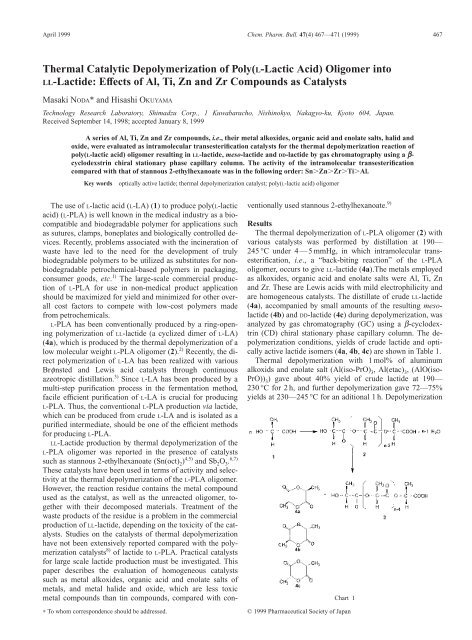
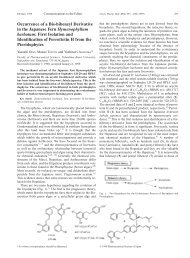

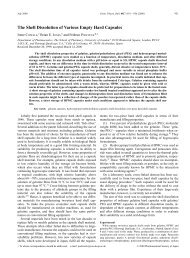
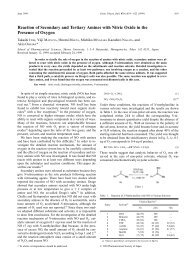
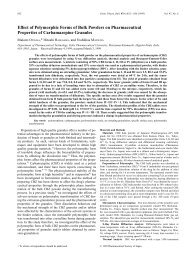
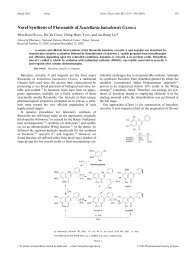
![Synthesis of 1-Azabicyclo[3.3.0]octane Derivatives and Their Effects ...](https://img.yumpu.com/5454096/1/190x259/synthesis-of-1-azabicyclo330octane-derivatives-and-their-effects-.jpg?quality=85)